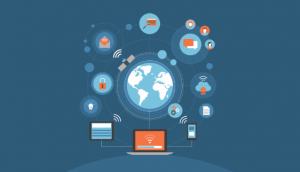The COVID-19 crisis spread so quickly around the world that most people, companies, organizations, and governments scrambled to address it in any way they could. In fact, if there’s something that defines the pandemic, that definitely has to be the lack of preparation for it. When faced with the Coronavirus threat, everyone did what they could, from adopting common-sense measures to resorting to trial and error methods.
That’s especially true for a lot of companies. Given the global and interconnected nature of today’s industries, the pandemic rapidly put the international business community under stress. There was a disruption in global supply chains, mandatory stay-at-home orders kept a large portion of the workforce idle, and highly-restrictive security measures were put in place changing how many companies do business.
With such a dire context, businesses of all sizes turned to whatever measure they had at hand’s reach. From adopting similar steps like the ones taken in the previous pandemic (like H1N1 influenza or swine flu pandemic of 2009) to improvising whatever felt right, many companies built their pandemic emergency plans with a mixture of traditional approaches coming from resilience plans designed for business continuity in case of major disruptions.
The problem is that the Coronavirus pandemic isn’t like something we’ve experienced recently. Not even the swine flu pandemic can be used for comparison, as today’s world is vastly different – as is the threat level of the COVID-19. That means that we are now trying different ways to limit the impact of the pandemic in our businesses, adjusting as we go.
The result of all that is that a lot of companies are discovering new ways of working, embracing different approaches for doing business, and trying their best to redefine their strategies for the short, mid, and long terms with the post-pandemic world on the horizon. Thus, it’s imperative that all businesses take the current situation as an opportunity to define pandemic planning that could inform future pandemic scenarios. Because, as unlikely as they’ve always seemed, once they strike, pandemics shouldn’t be addressed with rushed plans.
Here are some of the things all businesses should learn from the Coronavirus pandemic, all of which should be taken into consideration when developing future emergency plans.
The Importance of Pandemic Panning
Businesses have traditionally resorted to resilience planning to fight unforeseen disasters or disruptions and their consequences. It’s a fairly common procedure to have mapped-out plans for events like power outages, employee loss, data breaches, and other potentially harmful events that might come. Yet, those plans rarely include pandemics. The reason? Pandemics are a rare occurrence. However, that doesn’t mean businesses should ignore them because, as the Coronavirus is demonstrating, its consequences can be disastrous.
It’s possible that someone might argue that the basics of resilience planning can be adopted in the face of a pandemic to acceptable results but that’s simply not true. There are substantial differences between natural, human-made, technological, or operational disasters and the impact of a pandemic. From scale and severity to duration and general coordination, the disparities need to be accounted for if businesses are to properly respond in each scenario.
In that sense, it’s essential to acknowledge the importance of pandemic planning. During a traditional business disruption, the effects are much more localized and somewhat contained. The disruption can be more easily managed and solved, which makes it last less than a more serious threat. The workforce might be minimally affected and could lead to temporary shortages or to some repositionings. Common business disruptions might even have business coordinating efforts with public and government officials for a more appropriate response.
Pandemic disruptions, on the other hand, are more severe. Their effects are notoriously bigger to a point where the whole planet feels them. The disruption spreads more quickly and it’s harder to contain, which can make the disruption last for months on end. What’s more, the business response doesn’t depend on them, mostly, since governments and health officials are the ones calling the shots.
It’s true that certain aspects of a disruption caused by a natural disaster (like a hurricane or an earthquake) can be compared to those of a pandemic disruption. However, there’s a major difference in scale, since natural disasters are limited to a particular area. Additionally, pandemics can go beyond the areas where they originated and quickly spread throughout the globe.
All of this underlines the specificity of a pandemic which obviously calls for a plan as specific to meet the unique challenges that arrive with this disruption. That evidences the need for all of us in the business world to take what we can from the current pandemic to develop a resilience plan for potential future pandemics.
What COVID-19 Can Teach Businesses
Understanding that traditional resilience plans aren’t enough for addressing pandemics is just the starting point towards a comprehensive pandemic-focused plan. From there, it’s important to consider different challenges and devise actions around them. In that sense, the current Coronavirus crisis can help, as it’s showing us the aspects we need to consider in the development of a pandemic strategy.
Some of the most notable points include:
- People as a priority: this should be a no-brainer for everybody, yet it bears repeating. Since a pandemic poses a risk for public health, it’s important that companies adopt a people-first mindset. This translates into several actions. First and foremost, businesses need to provide safe workplaces for their employees that limit the possibility for contagion or that right-out takes it from the equation. This involves contemplating remote working practices, protective measures for on-site and essential workers, and shift in practices that mitigate the health risks.
Then, there’s the need for creating a support network or boosting any existing effort around it. In other words, companies need to consider the special needs of their employees and accommodate them in the best possible way. This includes providing extended child and elder care, safe transportation, access to informative resources, increased flexibility in schedules, and recognition for employees in key areas or that are tending to demands that exceed their roles.
The pandemic plan should include all this while also establishing proper communication channels that allow for direct feedback between the company and its employees. In that way, businesses can be sure they are always in touch with the people and that there are direct ways to address any concern.
- The geographical location of critical tasks: one of the most notorious effects of a global pandemic such as the Coronavirus’ is how quickly the entire business landscape can come to a halt. The globalized nature of most business activities multiplies this effect, especially felt in bigger companies and enterprises. Third-party vendors, supply chain partners, and external service providers can be affected way before a company is hit, making the effect of the pandemic felt in advance, causing further disruption.
That’s why a pandemic plan should explicitly describe the most essential activities, roles, and locations while also providing mitigation strategies in case one, some, or most of them are affected by a pandemic. This means working on a segmentation strategy that reduces the dependence on a single location, team, or vendor. By diversifying the relevant nodes within the corporate networks, companies reduce the number of single points of failure, something that’s beneficial even in the face of non-pandemic disruptions.
- Third-party reliance: most companies today work with offshore software development vendors, cloud service providers, payment agencies, and other service suppliers distributed across the world. As any company that has hired any of these already knows, there’s a strict vetting process before committing to third parties that ensure the quality and continuity of the provided services. Since the Coronavirus pandemic, the vetting process should also include their reliability in case of global disruptions.
That means that, as a part of pandemic planning, companies should make sure that all third parties have strong pandemic plans of their own to address the significant impact that comes with a major threat. Vendors that don’t have such a plan shouldn’t be considered, as they would become points of failure if a major disruption strikes.
Additionally, companies working with third-party providers should also prepare for the possibility that one or multiple suppliers are impaired during the pandemic. Since such health crises imply a threat to everyone, businesses shouldn’t have blind faith in the vendors’ pandemic planning. Thus, companies should have alternative providers that can step up.
- Tech infrastructure: the Zoom phenomenon that took place during these months of the pandemic shows the importance of having the right technology and infrastructure to deal with potential disruptions stemming from a pandemic. When confronted with remote working as the sole alternative to keep operating, a lot of businesses did a minor research process and settled for Zoom as their primary communication channel, even when the application wasn’t prepared, especially in security terms.
This small example underlines the importance of planning ahead of a pandemic to ensure that remote working (a highly likely practice in the case of a major health crisis) can be carried out seamlessly and without risks. Pandemic planning should make sure that the IT infrastructure has everything needed for remote working to perform as expected from day one.
That means several things. First, it means having the right physical infrastructure to accommodate more traffic in private networks. Then, it means having the best possible tools for each task that needs to be completed remotely, from accounting software to communication solutions. Finally, it also means that the employees should have the necessary tools and knowledge to work from their homes. Companies shouldn’t wait for a pandemic to teach their workforces about cloud-based solutions or remote tools – this should be an essential part of pandemic planning.
- Communication strategy: as the Coronavirus pandemic has shown us, isolation and social distancing become common measures that have a significant impact on our daily lives. Both of them shift the focus and boost the importance of having the right communication strategy in place, both for internal organization and for external affairs. It’s not enough to have the right tools to communicate to employees, suppliers, and customers – there has to be a strategic plan behind it all.
First and foremost, this translates into the need to understand all of the communication channels as one big environment that needs to be perfectly orchestrated to avoid misunderstandings and additional disruptions. From social media channels to call centers and PR releases, everything has to be on the same page in terms of the message and the overall strategy.
A communication strategy also implies dealing with the rise of fake news and false narratives that inevitably appear during stressful times. This can have several implications, from being extra careful with the dissemination of certain information without the proper checking process to the need of being proactive and empathic when engaging with fake news regarding company-related products, services, or practices.
Finally, the communication strategy should also contemplate the best way to communicate with customers. Every little disruption that might impact a company’s customer base (shipping delays, product shortages, price adjustments) needs to be clearly disclosed across all available channels. Transparency should be the highest objective when dealing with customer concerns, especially during delicate instances, such as issues that might appear after purchases.
- Internal adjustments: a pandemic almost always spans in time and shifts its nature as weeks go by. These changes can have a significant impact on a company’s infrastructure, products, and services which, ultimately, can force the businesses to reprioritize their efforts. Fluctuations in the market and new customer needs can also test a company’s ability to quickly shift gears.
In that way, pandemic planning needs to contemplate the potential adjustments that might take place to meet a pandemic’s ever-changing scenario. Among the strategies that should be identified, there’s the need to look into resource repositioning, product discontinuation, real-time reporting, quick decision-making, and improved backend quality control processes.
The shifting nature of the pandemic can also force companies to implement critical exceptions across numerous areas, from human resources to the finance departments. Pandemic planning should take these exceptions into account and make sure that there are procedures to expedite them as much as possible while also managing the risks associated with this readjustment of practices.
- General context: there are some business disruptions that more or less fall into the domain of a particular company. However, pandemics aren’t among them. A global health crisis exceeds the company’s limits by far, which means that there are many other actors with superior prominence on decision making. That means that companies have to adhere to a general context dictated by people in charge of public well-being.
That means that all pandemic responses coming from a private company need to be articulated with the public actions of government and institutions. That means that companies need to support international, national, and local officials and institutions in their messages and recommendations. Thus, pandemic planning implies the definition of the core institutions that will set the rules the company will follow.
It also means that companies need to be proactive when ensuring that their actions don’t get in the way of public actions. Thus, businesses can play an important role in helping with the manufacturing and distribution of important resources, the grant of assistance programs for their employees, and the organization of localized relief tasks in their areas.
A Huge Learning Opportunity
The Coronavirus pandemic surely is the defining moment of the 21st century. No one can anticipate what kind of world we’ll see after all this is over. The only thing we can work beforehand is learning from this experience to apply that knowledge in such a way that, when this happens again, we mitigate the risks and impact associated with a pandemic.
For businesses, this means taking pandemic planning seriously. Instead of dismissing it as unnecessary, the entire business world should take the opportunity to review its practices during this crisis and see what can be improved in the future. Doing so can lead to a better way of doing business, one that puts people first while reducing the economic disruption to a minimum.
Business & Finance Articles on Business 2 Community
(94)
Report Post





